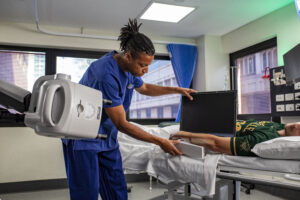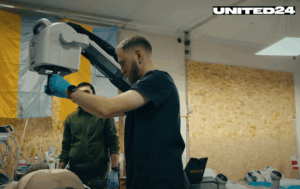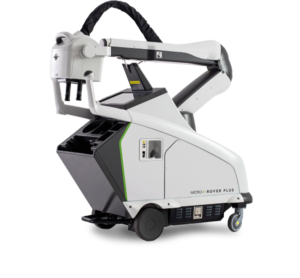From hot filaments to cold electrons - a quantum leap in imaging technology.
The Core Innovation: From Hot Cathode to Cold Cathode
For more than a century, X-ray tubes have relied on thermionic emission — heating a filament inside an oil bath to produce electrons. This traditional approach, while effective, requires bulky cooling systems, heavy shielding, and frequent maintenance.
Nano Electronic X-ray (NEX) technology replaces this legacy design with a carbon nanotube (CNT)–based cold cathode system. Instead of heat, electrons are released instantly when voltage is applied — a process called field emission.
Each CNT acts like a microscopic switch that can turn on and off in microseconds, allowing for instantaneous X-ray generation with unprecedented precision and control.
Precision, Performance, and Control
The combination of cold cathode and CNT field emission technology offers several advantages:
⚡ Instant Electron Emission: Electrons are released at room temperature, enabling immediate X-ray generation — no warm-up time required.
🎯 Pinpoint Dose Control: Because each nanotube is individually addressable, systems can modulate electron output in real time, supporting precise, repeatable exposures.
🏥 High-Quality Imaging: NEX-powered systems have been demonstrated to deliver high-resolution, diagnostic-quality digital images despite their smaller form factor.
🔄 Reliability and Longevity: Micro-X testing shows emitter lifetimes up to 29 years under controlled conditions, offering a potential reduction in maintenance and downtime.
The Power of Portability
By removing the heavy cooling systems and oil baths required by hot cathode designs, NEX tubes weigh as little as 1.5 kg, compared to 18–20 kg for conventional tubes.
This massive reduction enables smaller, lighter, and more mobile imaging platforms. For instance, Rover Plus — a portable digital X-ray system powered by a lithium iron phosphate battery — can be easily moved without motors.
This compact, energy-efficient design may allow hospitals, clinics, and emergency teams to bring imaging closer to the point of care.
Enabling New Applications and Environments
The portability and scalability of cold cathode X-ray systems are unlocking new opportunities beyond traditional hospital settings:
-
Point-of-Care Imaging: Bringing high-quality imaging directly to patient bedsides in ICUs, NICUs, and ERs.
-
Pre-Hospital Diagnostics: Development of compact Head CT prototypes designed to fit in ambulances and aircraft for potential stroke triage applications.
-
Remote and Field Medicine: NEX-based designs could extend diagnostic imaging to rural, military, or humanitarian missions.
-
Security and Aerospace: Compact, stable, low-heat designs may support applications in security scanning and long-duration space missions.




💡 The Future Unfolds — New Frontiers with Nano Electronic X-ray (NEX) Technology
What if the world’s most advanced imaging systems weren’t confined to hospitals?
What if CT-level imaging could one day travel with patients — or high-quality X-rays could reach remote clinics and field hospitals?
That future is emerging through Micro-X’s Nano Electronic X-ray (NEX) technology — a platform that re-engineers how X-rays are generated and delivered.
🔬 From the Lab to the Field
Across this series, we’ve explored how NEX changes the fundamentals of imaging:
✅ Miniaturization — smaller, lighter, and more mobile.
✅ Precision — instant, electronically controlled X-ray generation.
✅ Reliability — no filaments, no oil, no heavy cooling systems.
These engineering shifts are now inspiring new directions in medical and industrial imaging research.
🌍 New Frontiers in Imaging
🚑 Pre-Hospital Stroke Triage
Micro-X is developing compact Head CT prototypes designed for standard ambulances — aiming to enable imaging in transit and potentially reduce time to diagnosis once systems receive regulatory clearance.
🏥 Remote & Resource-Limited Care
Battery-powered, wireless imaging platforms are being engineered to extend hospital-grade imaging capability to rural clinics, military field hospitals, and disaster-response environments.
🧠 Next-Generation CT Architectures
In collaboration with Johns Hopkins University, Micro-X is researching curved arrays of mini X-ray tubes and detectors — exploring how multi-source designs could improve imaging speed and portability.
🛰 Beyond Earth
Because cold-cathode systems generate minimal heat and require no oil, they are being evaluated for future aerospace and long-duration space applications where reliability and low mass are essential.
🧪 Scientific Validation
These advances rest on growing scientific evidence.
A 2025 Wiley Online Library study, “Superior Carbon Nanotube Field Emission for X-Ray,” reported improved emitter uniformity and stability in CNT-based vacuum devices. 👉 https://onlinelibrary.wiley.com/doi/10.1002/smll.202500242
Likewise, research in Nanomaterials (MDPI, 2024) demonstrated gated CNT cold-cathode emitters maintaining current stability within 0.5 % over extended operation — confirming the precision and repeatability of field-emission control. 👉 https://www.mdpi.com/2079-4991/12/11/1882
These materials-science results support the underlying physics of NEX field-emission design and its long-life potential.
🌟 The Big Picture
NEX technology represents a generational shift — a movement from thermionic to electronic control, from heavy and fixed systems to lightweight and mobile platforms. NEX isn’t just a new tube — it represents a step toward more distributed, responsive imaging ecosystems.
By merging nanotechnology, electronics, and medical engineering, it points to a future where diagnostic imaging moves closer to the point of care — and further into environments where it was once impossible.
From hospitals to ambulances, from remote outposts to orbit — imaging is becoming smaller, smarter, and more connected than ever before.
🔗 Learn More:
Explore how NEX technology is redefining mobile medical imaging: 👉 Micro-X Rover Plus
👀 Stay Informed: Follow us on LinkedIn for updates on next-generation imaging technology and upcoming clinical milestones.
📜 Regulatory Disclaimer
Performance and economic outcomes for Lighthouse X-ray solutions may vary based on clinical workflow, patient population, equipment usage, and maintenance practices. All claims of performance, reliability, or cost impact are based on design intent, internal testing, or published data when cited. This information is intended for healthcare professionals and institutional decision-makers only. Clinical and purchasing decisions should be made based on the full review of product labeling, technical specifications, and applicable institutional requirements. ⚠️ Rx Only.


